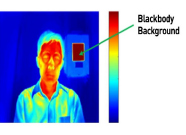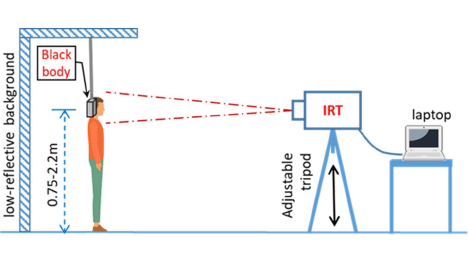Frequently Asked Questions About Thermal Imaging
What is thermal imaging?
Thermal imaging is a method that detects heat coming from the surface of the body. At RWJ University Hospital Hamilton, our system utilizes a sophisticated computerized software and camera system to accurately measure temperature data. Thermal imaging is supported by over 40 years of research and thousands of published medical studies. FDA clearance was gained and from that point it started its emergence within the industry.
How do thermal imaging cameras work?
 Thermal imaging cameras, also called infrared cameras, detect heat naturally
given off by all object or person. Thermal imaging cameras have lenses,
just like any other cameras but in this case the lens focuses only on
heat waves present in objects. Thousands of sensors convert the energy
readings into an electrical signal which creates a video image forming
a “thermal profile”. The hotter a subject the more heat it
produces. Thermal cameras can see this heat and convert it to an image
we can then see with our eyes. For example, you’ll notice in the
photo the person is covered in shades of red, orange, and yellow. That’s
because in this illustration the person is warmer than the surrounding
air and appears “brighter” while the cooler surrounding air
and buildings appear in varying “cooler” shades of purple
and blue. Again colder temperatures are shades of blue, purple, or green,
while warmer temperatures appear in shades of red, orange, or yellow.
At RWJ University Hospital Hamilton, our thermal camera system is registered
with the U.S. Food and Drug Administration (FDA) for this application
and with this capability, we can deploy it as a rapid non-contact screening tool.
Thermal imaging cameras, also called infrared cameras, detect heat naturally
given off by all object or person. Thermal imaging cameras have lenses,
just like any other cameras but in this case the lens focuses only on
heat waves present in objects. Thousands of sensors convert the energy
readings into an electrical signal which creates a video image forming
a “thermal profile”. The hotter a subject the more heat it
produces. Thermal cameras can see this heat and convert it to an image
we can then see with our eyes. For example, you’ll notice in the
photo the person is covered in shades of red, orange, and yellow. That’s
because in this illustration the person is warmer than the surrounding
air and appears “brighter” while the cooler surrounding air
and buildings appear in varying “cooler” shades of purple
and blue. Again colder temperatures are shades of blue, purple, or green,
while warmer temperatures appear in shades of red, orange, or yellow.
At RWJ University Hospital Hamilton, our thermal camera system is registered
with the U.S. Food and Drug Administration (FDA) for this application
and with this capability, we can deploy it as a rapid non-contact screening tool.
How do infrared thermometers take my temperature?
 Often, when people use handheld infrared temperature scanner it will get
point at the individual’s forehead. However, using this area results
in significant differences when obtaining readings. One of the best areas
for a thermometer reading actually turns out to be the inner canthus (tear
duct) of the eye — right in the inner corner. This is the hottest
part of the human face and is where our system measures when you’re asked to
remove any eye wear and look at the camera.
Often, when people use handheld infrared temperature scanner it will get
point at the individual’s forehead. However, using this area results
in significant differences when obtaining readings. One of the best areas
for a thermometer reading actually turns out to be the inner canthus (tear
duct) of the eye — right in the inner corner. This is the hottest
part of the human face and is where our system measures when you’re asked to
remove any eye wear and look at the camera.
 Is thermal imaging dangerous?
Is thermal imaging dangerous?
No. In fact, our thermal imaging system is a non-contact, non-invasive, passive imaging system that is measuring the heat emitted, or given off, by the human body. Our thermal imaging systems uses a proprietary software to provide an estimated core temperature, as well as a surface temperature. The thermal imager does not emit any form of radiation.
What about if I’m pregnant?
The scanner bounces waves off your body surface which then go back to the machine for processing. The level of radiation you're exposed to during this process is lower than what is given off from your phone. At these very low levels, exposure is considered safe for everyone, including pregnant women.
Are individuals recorded during thermal imaging scans?
At RWJ University Hospital Hamilton, our thermal cameras detect heat profiles only and DOES NOT record or store images in any way.
What’s the purpose of changing to a Thermal Imaging System?
Operating the temperature station previously required personnel to be physically in close proximity to each person being evaluated. Utilizing this new process provides operators handling the thermal imaging system the space to safely distance and could even be located in a different area or room. In addition, the thermal imaging system is an improvement in technology measuring temperature at a much faster speed than the typical forehead or oral (mouth) thermometer significantly reducing wait time.
Are there any limitations of using a Thermal Imaging System?
This new system is used only for initial temperature assessment. Not removing eyewear, hat, or mask temporarily during the screening can result in an erroneous reading. In addition, when screening individuals coming into our building entrances the technology CANNOT take the temperature of multiple people at the same time.
Can our thermal cameras be used to detect a virus such as the novel Coronavirus (COVID-19)?
No. Thermal cameras are NOT a diagnostic tool. It’s designed for early detection. Temperature-based screening using thermal imaging cannot effectively determining if someone definitively has COVID-19 because, among other things, a person with COVID-19 may not have a fever. A diagnostic specific test must be performed to determine if someone has COVID-19.
What happens if the thermal camera shows I have a high temperature?
If an increased temperature is seen using the thermal imaging system, you will be required to wait and get a secondary confirmation utilizing a different method at the screen station to confirm a fever.



